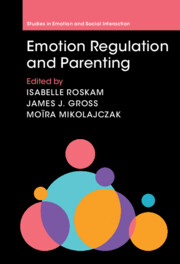Book contents
- Emotion Regulation and Parenting
- Studies in Emotion and Social Interaction
- Emotion Regulation and Parenting
- Copyright page
- Contents
- Figures
- Tables
- Contributors
- Preface
- Part I Conceptual Foundations
- Part II Influence of Parents’ Emotion Regulation on Parenting
- Chapter 3 The Role of Parents’ Emotion Regulation in Supporting Parenting Behaviors and Practices
- Chapter 4 Parental Emotion Regulation: The Role of Parents’ Own Childhood Maltreatment
- Chapter 5 The Role of Parental Emotion Regulation in Parental Neglect and Violence
- Chapter 6 Parental Emotion Regulation, Stress, and Burnout
- Part III Influence of Parenting on Child Emotion Regulation
- Part IV Current Trends
- Index
- Studies in Emotion and Social Interaction
- References
Chapter 6 - Parental Emotion Regulation, Stress, and Burnout
from Part II - Influence of Parents’ Emotion Regulation on Parenting
Published online by Cambridge University Press: 05 January 2024
- Emotion Regulation and Parenting
- Studies in Emotion and Social Interaction
- Emotion Regulation and Parenting
- Copyright page
- Contents
- Figures
- Tables
- Contributors
- Preface
- Part I Conceptual Foundations
- Part II Influence of Parents’ Emotion Regulation on Parenting
- Chapter 3 The Role of Parents’ Emotion Regulation in Supporting Parenting Behaviors and Practices
- Chapter 4 Parental Emotion Regulation: The Role of Parents’ Own Childhood Maltreatment
- Chapter 5 The Role of Parental Emotion Regulation in Parental Neglect and Violence
- Chapter 6 Parental Emotion Regulation, Stress, and Burnout
- Part III Influence of Parenting on Child Emotion Regulation
- Part IV Current Trends
- Index
- Studies in Emotion and Social Interaction
- References
Summary
It is becoming increasingly clear that emotion regulation (ER) plays a crucial role in parenting. In this chapter, we consider the role of parental ER in parental stress and parental burnout. In the first section, we define ER and its various facets in the parenting domain. In the second section, we focus on the protective role of parent’s self-focused (intrinsic) ER vis-à-vis parenting stress and burnout. Specifically, we show how parents’ efficient regulation of their own emotions mitigates parenting stress levels and reduces the risk for parental burnout. In the third section, we focus on the protective role of parent’s child-focused (extrinsic) ER vis-à-vis parenting stress and burnout. Specifically, we show how parents’ efficient regulation of their child(ren)’s emotions reduces their own parenting stress. Because perfect is often the enemy of good in the parenting domain, the fourth section presents recent evidence showing that too much ER may backfire and lead to increased parenting stress and burnout in the long run. Finally, we conclude with the most pressing research directions emerging from the evidence reviewed in this chapter.
Keywords
- Type
- Chapter
- Information
- Emotion Regulation and Parenting , pp. 116 - 126Publisher: Cambridge University PressPrint publication year: 2023



